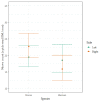A Comparative Neuro-Histological Assessment of Gluteal Skin Thickness and Cutaneous Nociceptor Distribution in Horses and Humans
- PMID: 33187204
- PMCID: PMC7696388
- DOI: 10.3390/ani10112094
A Comparative Neuro-Histological Assessment of Gluteal Skin Thickness and Cutaneous Nociceptor Distribution in Horses and Humans
Abstract
The current project aims to build on knowledge of the nociceptive capability of equine skin to detect superficial acute pain, particularly in comparison to human skin. Post-mortem samples of gluteal skin were taken from men (n = 5) and women (n = 5), thoroughbreds and thoroughbred types (mares, n = 11; geldings, n = 9). Only sections that contained epidermis and dermis through to the hypodermis were analysed. Epidermal depth, dermal depth and epidermal nerve counts were conducted by a veterinary pathologist. The results revealed no significant difference between the epidermal nerve counts of humans and horses (t = 0.051, p = 0.960). There were no significant differences between epidermal thickness of humans (26.8 µm) and horses (31.6 µm) for reference (left side) samples (t = 0.117, p = 0.908). The human dermis was significantly thinner than the horse dermis (t = -2.946, p = 0.007). Epidermal samples were thicker on the right than on the left, but only significantly so for horses (t = 2.291, p = 0.023), not for humans (t = 0.694, p = 0.489). The thicker collagenous dermis of horse skin may afford some resilience versus external mechanical trauma, though as this is below the pain-detecting nerve endings, it is not considered protective from external cutaneous pain. The superficial pain-sensitive epidermal layer of horse skin is as richly innervated and is of equivalent thickness as human skin, demonstrating that humans and horses have the equivalent basic anatomic structures to detect cutaneous pain. This finding challenges assumptions about the physical capacity of horses to feel pain particularly in comparison to humans, and presents physical evidence to inform the discussion and debate regarding the ethics of whipping horses.
Keywords: dermis; epidermis; innervation; nerve cell counts; pain; whipping.
Conflict of interest statement
The authors declare no conflict of interest.
Figures








Similar articles
-
Normal microscopic anatomy of equine body and limb skin: A morphological and immunohistochemical study.Ann Anat. 2018 Jul;218:205-212. doi: 10.1016/j.aanat.2018.03.010. Epub 2018 May 3. Ann Anat. 2018. PMID: 29730469
-
An anatomic comparison of the skin of five donor sites for dermal fat graft.Ann Plast Surg. 2001 Mar;46(3):327-31. doi: 10.1097/00000637-200103000-00021. Ann Plast Surg. 2001. PMID: 11293528
-
Zonal dermal separation: a distinctive histopathological lesion associated with hyperelastosis cutis in a Quarter Horse.Vet Dermatol. 2001 Aug;12(4):219-24. doi: 10.1046/j.0959-4493.2001.00256.x. Vet Dermatol. 2001. PMID: 11493407
-
Characterization and mechanisms of photoageing-related changes in skin. Damages of basement membrane and dermal structures.Exp Dermatol. 2016 Aug;25 Suppl 3:14-9. doi: 10.1111/exd.13085. Exp Dermatol. 2016. PMID: 27539897 Review.
-
The epidermis: a sensory tissue.Eur J Dermatol. 2008 Mar-Apr;18(2):119-27. doi: 10.1684/ejd.2008.0348. Eur J Dermatol. 2008. PMID: 18424369 Review.
Cited by
-
Elucidation of collagen content in different anatomical regions of the dermis of donkeys (Equus asinus): histomorphometric and ultrastructural study.BMC Vet Res. 2025 May 2;21(1):310. doi: 10.1186/s12917-025-04712-0. BMC Vet Res. 2025. PMID: 40317011 Free PMC article.
-
No More Evasion: Redefining Conflict Behaviour in Human-Horse Interactions.Animals (Basel). 2025 Jan 31;15(3):399. doi: 10.3390/ani15030399. Animals (Basel). 2025. PMID: 39943169 Free PMC article.
-
Using an Equine Cadaver Head to Investigate Associations Between Sub-Noseband Space, Noseband Tension, and Sub-Noseband Pressure at Three Locations.Animals (Basel). 2025 Jul 19;15(14):2141. doi: 10.3390/ani15142141. Animals (Basel). 2025. PMID: 40723604 Free PMC article.
-
The cannabinoid receptors system in horses: Tissue distribution and cellular identification in skin.J Vet Intern Med. 2022 Jul;36(4):1508-1524. doi: 10.1111/jvim.16467. Epub 2022 Jul 8. J Vet Intern Med. 2022. PMID: 35801813 Free PMC article.
-
The race that segments a nation: Findings from a convenience poll of attitudes toward the Melbourne Cup Thoroughbred horse race, gambling and animal cruelty.PLoS One. 2021 Mar 24;16(3):e0248945. doi: 10.1371/journal.pone.0248945. eCollection 2021. PLoS One. 2021. PMID: 33760873 Free PMC article.
References
-
- Jones B., McGreevy P.D. Ethical equitation: Applying a cost-benefit approach. J. Vet. Behav. 2010;5:196–202. doi: 10.1016/j.jveb.2010.04.001. - DOI
-
- McGreevy P.D., Oddie C. Holding the whip hand-A note on the distribution of jockeys’ whip hand preferences in Australian Thoroughbred racing. J. Vet. Behav. 2011;6:287–289. doi: 10.1016/j.jveb.2011.02.010. - DOI
Grants and funding
LinkOut - more resources
Full Text Sources

